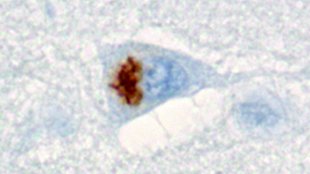A repetitive DNA sequence that was not believed to encode proteins is, in fact, the source of insoluble peptide chains that aggregate in the brain cells of patients displaying certain types of neurodegeneration, according to a study published today (February 7) in Science. These aggregates occur in a wide range of neurodegenerative disorders, so determining their identity is an important first step towards understanding how they might contribute to various pathologies.
“It’s a very exciting and important paper,” said Bruce Miller, a professor of neurology at the University of California, San Francisco, who was not involved in the study. “We’ve all been waiting, in the field, for someone to make this breakthrough, so I’m just thrilled.”……







